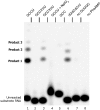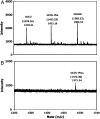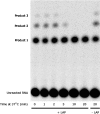Multiple translational products from a five-nucleotide ribozyme - PubMed
- ️Fri Jan 01 2010
Multiple translational products from a five-nucleotide ribozyme
Rebecca M Turk et al. Proc Natl Acad Sci U S A. 2010.
Abstract
An indispensable step in protein biosynthesis is the 2(')(3(')) aminoacylation of tRNA by aminoacyl-tRNA synthetases. Here we show that a similar activity exists in a tiny, 5-nt-long RNA enzyme with a 3-nt active center. The small ribozyme initially trans-phenylalanylates a partially complementary 4-nt RNA selectively at its terminal 2(')-ribose hydroxyl using PheAMP, the natural form for activated amino acid. The initial 2(') Phe-RNA product can be elaborated into multiple peptidyl-RNAs. Reactions do not require divalent cations, and have limited dependence on monovalent cations. Small size and minimal requirements for regiospecific translational activity strongly support the hypothesis that minuscule RNA enzymes participated in early forms of translation.
Conflict of interest statement
The authors declare no conflict of interest.
Figures

Small trans-aminoacylating RNA complexes. (A) C3 RNA. (B) Intermediate trans complexes. (C) Final GUGGC/GCCU complex.

Initial reaction occurs only at 2′-OH. Lanes: 1, substrate = GCCU; 2, GCC2′dU; 3, GCC3′dU; 4, GCCU + NaIO4; 5, GCC; 6, dGdCdCrU; 7, GCCU + PheAMP, no GUGGC; 8, GCCU + GUGGC, no PheAMP. Reaction conditions: 10 μM ribozyme GUGGC, 20 μM RNA substrate, 100 mM KCl, 5 mM MgCl2, 100 mM Hepes pH 7.0, 2.0 mM PheAMP; incubation at 4 °C for 30 min.

Aminoacylation reaction does not require divalent cations. All reactions contained 10 μM GUGGC, 20 μM GCCU, 1.9 mM PheAMP, 100 mM Hepes pH 6.5, 10 mM NaOH. Reactions contained 100 mM KCl, 5 mM MgCl2, or 100 mM NaCl where indicated. Incubation at 4 °C for 60 min.

MALDI-TOF mass spectrometric analysis of RNA and Products 1 and 2. (A) Product 1 and RNA. (B) Product 2. Numbers in parentheses indicate theoretical mass of protonated products; outside parentheses, observed mass.

Higher products are RNA peptides. Aminoacylation reaction conditions: 10 μM GUGGC, 20 μM GCCU, 100 mM KCl, 5 mM MgCl2, 100 mM Hepes pH 7.0, 1 mM PheAMP; incubation at 4 °C for 30 min. LAP, leucine aminopeptidase, 23 ng/μL.
Similar articles
-
The meaning of a minuscule ribozyme.
Yarus M. Yarus M. Philos Trans R Soc Lond B Biol Sci. 2011 Oct 27;366(1580):2902-9. doi: 10.1098/rstb.2011.0139. Philos Trans R Soc Lond B Biol Sci. 2011. PMID: 21930581 Free PMC article.
-
Catalyzed and spontaneous reactions on ribozyme ribose.
Turk RM, Illangasekare M, Yarus M. Turk RM, et al. J Am Chem Soc. 2011 Apr 20;133(15):6044-50. doi: 10.1021/ja200275h. Epub 2011 Mar 25. J Am Chem Soc. 2011. PMID: 21438575
-
Structural basis of specific tRNA aminoacylation by a small in vitro selected ribozyme.
Xiao H, Murakami H, Suga H, Ferré-D'Amaré AR. Xiao H, et al. Nature. 2008 Jul 17;454(7202):358-61. doi: 10.1038/nature07033. Epub 2008 Jun 11. Nature. 2008. PMID: 18548004
-
How Natural Enzymes and Synthetic Ribozymes Generate Methylated Nucleotides in RNA.
Höbartner C, Bohnsack KE, Bohnsack MT. Höbartner C, et al. Annu Rev Biochem. 2024 Aug;93(1):109-137. doi: 10.1146/annurev-biochem-030222-112310. Epub 2024 Jul 2. Annu Rev Biochem. 2024. PMID: 38598854 Review.
-
Scott WG. Scott WG. Biochem Soc Trans. 1996 Aug;24(3):604-8. doi: 10.1042/bst0240604. Biochem Soc Trans. 1996. PMID: 8878812 Review. No abstract available.
Cited by
-
How amino acids and peptides shaped the RNA world.
van der Gulik PT, Speijer D. van der Gulik PT, et al. Life (Basel). 2015 Jan 19;5(1):230-46. doi: 10.3390/life5010230. Life (Basel). 2015. PMID: 25607813 Free PMC article. Review.
-
The Future of Origin of Life Research: Bridging Decades-Old Divisions.
Preiner M, Asche S, Becker S, Betts HC, Boniface A, Camprubi E, Chandru K, Erastova V, Garg SG, Khawaja N, Kostyrka G, Machné R, Moggioli G, Muchowska KB, Neukirchen S, Peter B, Pichlhöfer E, Radványi Á, Rossetto D, Salditt A, Schmelling NM, Sousa FL, Tria FDK, Vörös D, Xavier JC. Preiner M, et al. Life (Basel). 2020 Feb 26;10(3):20. doi: 10.3390/life10030020. Life (Basel). 2020. PMID: 32110893 Free PMC article.
-
Liu Z, Rigger L, Rossi JC, Sutherland JD, Pascal R. Liu Z, et al. Chemistry. 2016 Oct 10;22(42):14940-14949. doi: 10.1002/chem.201602697. Epub 2016 Aug 18. Chemistry. 2016. PMID: 27534830 Free PMC article.
-
Walker SI, Grover MA, Hud NV. Walker SI, et al. PLoS One. 2012;7(4):e34166. doi: 10.1371/journal.pone.0034166. Epub 2012 Apr 6. PLoS One. 2012. PMID: 22493682 Free PMC article.
-
Liu Z, Ajram G, Rossi JC, Pascal R. Liu Z, et al. J Mol Evol. 2019 Apr;87(2-3):83-92. doi: 10.1007/s00239-019-9887-7. Epub 2019 Feb 20. J Mol Evol. 2019. PMID: 30788531 Free PMC article.
References
-
- Gilbert W. The RNA world. Nature. 1986;319:618.
-
- White HB., III Coenzymes as fossils of an earlier metabolic state. J Mol Evol. 1976;7:101–104. - PubMed
-
- Guerrier-Takada C, Gardiner K, Marsh T, Pace N, Altman S. The RNA moiety of ribonuclease P is the catalytic subunit of the enzyme. Cell. 1983;35:849–857. - PubMed
-
- Kruger K, et al. Self-splicing RNA: Autoexcision and autocyclization of the ribosomal RNA intervening sequence of Tetrahymena. Cell. 1982;31:147–157. - PubMed
-
- Yarus M. On translation by RNAs alone. Cold Spring Harb Sym. 2001;66:207–215. - PubMed
Publication types
MeSH terms
Substances
LinkOut - more resources
Full Text Sources
Other Literature Sources
Research Materials